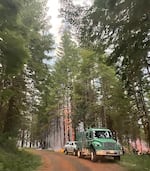People fighting the now-1,600-acre Camp Creek Fire in the Bull Run watershed and reservoir complex said Monday that cooler weather is giving them a break.
Lightning sparked the fire last week in the forested area about 25 miles east of Portland.
The first grew over the weekend and remained uncontained Monday. But Matt Call with the Great Basin Fire management team said cooler, wetter weather is slowing the fire’s spread and letting crews fight it more efficiently.
“The moisture is going to slow the fire down quite a bit,” he said. “But it’s not going to put it out.”
The fire is burning about a mile south of the Bull Run reservoir, in a watershed that’s protected from logging. The watershed collects drinking water from 102 square miles of temperate rainforest and delivers it downhill to Portland, Gresham, Beaverton and Tigard, among other jurisdictions.
The area is full of old trees and vegetation that are especially combustible at this time of year.
“We have a lot of fuel out there,” Call said. “We have a lot of really old-growth trees and a lot of organic material that’s several feet deep.”
Fire officials said over the weekend they expected the fire to continue growing, “We still have a lot of work ahead of us,” Call said.
Water safe for now
The Bull Run watershed provides drinking water to about 1 million people. That’s a quarter of all Oregonians. So whenever fire approaches the watershed, water quality becomes a worry.
Scott Bradway, the Portland Water Bureau’s water quality information manager, said there’s no reason to worry yet.
“Our drinking water quality from here in Portland is just fine right now,” he said.
Portland’s reservoir contains 2-point-4 billion gallons of water. So even if the fire grows or the wind changes and ash starts to fall into the water, there’s little risk, “So any ash or anything that’s falling into it is going to get diluted pretty significantly,” Bradway said.
He points to the Eagle Creek Fire in 2017. The winds blew a lot of ash into the Bull Run that year. “And we didn’t see any impacts to our drinking water during that fire,” he said.
More than ash getting into the water, city leaders are concerned about the safety of employees at the Bull Run Headworks water treatment facility. It’s the building where drinking water is allowed to settle and be disinfected. The fire was about three miles from the structure Monday.
Portland Fire & Rescue describes the treatment facility as a defensible building, but fire crews have set up a temporary sprinkler system on location. They have also put fire protection wrap in place.
“Fortunately, that facility is located on the other side of the reservoir from where the fire is,” Bradway said. “So right now we feel like it’s pretty well protected.”
If the Camp Creek Fire were to grow significantly in the direction of the treatment facility, staff would have to be evacuated and the treatment facility would shut down. At that point, Bull Run water would no longer be available and the Water Bureau would need to rely on the Columbia South Shore Well Field, a collection of groundwater wells sometimes used to supplement Bull Run water, and potentially explore other options as well.
“Our groundwater system was really designed to replace the Bull Run when there is less demand,” Bradway said. “So we would have to find some other resources to be able to continue to supply drinking water to the full region.”
Bradway said the bureau is working with other regional water systems to identify ways to reduce demand.
In a worst-case scenario, the water bureau would ask customers to reduce water usage.
“But we’re not there yet,” Bradway said. “There’s no need for that at the moment.”
How to track the fire
Bradway said if people want to be prepared they can follow the Water Bureau on Facebook or at its Camp Creek information page.
“I think this is a great opportunity to remind people that emergencies can happen, whether it’s a forest fire or an earthquake,” he said. “It’s always a good idea to keep an emergency supply of emergency water on hand.”
Natural materials fall into the Bull Run all the time. But if the number of particulates, or cloudiness of the water increases dramatically, the treatment facility would have to close. That’s largely because it delivers unfiltered water.
Clearing cloudy water does not usually involve adding chemicals. Instead it’s a process of waiting for particulates to settle out or of flushing water out into the river system.
Portland Water Bureau’s treatment facility at Bull Run is an unfiltered system. The agency is in the process of building a replacement plant which will filter the water.
“So in the future, if these types of situations would happen we would be better equipped to handle increased turbidity (cloudy with suspended matter) from a forest fire like this,” said Bradway.
Construction is scheduled to start this year and end in 2027.
Meanwhile, the Camp Creek fire continues to burn. The Great Basin Fire management team is asking federal officials for more equipment and staff to fight the fire.

Firefighters in initial attack on Camp Creek Fire, on August 25, 2023.
Courtesy of Inciweb
